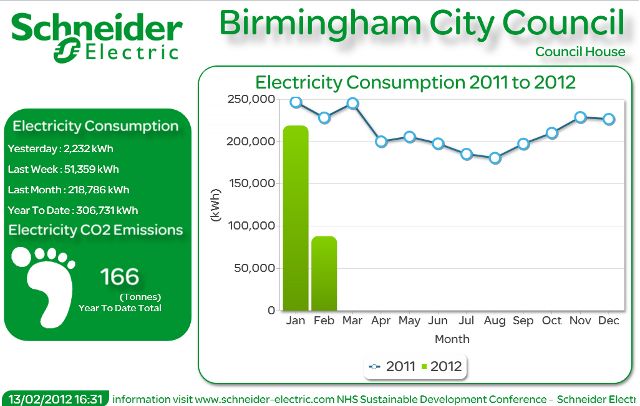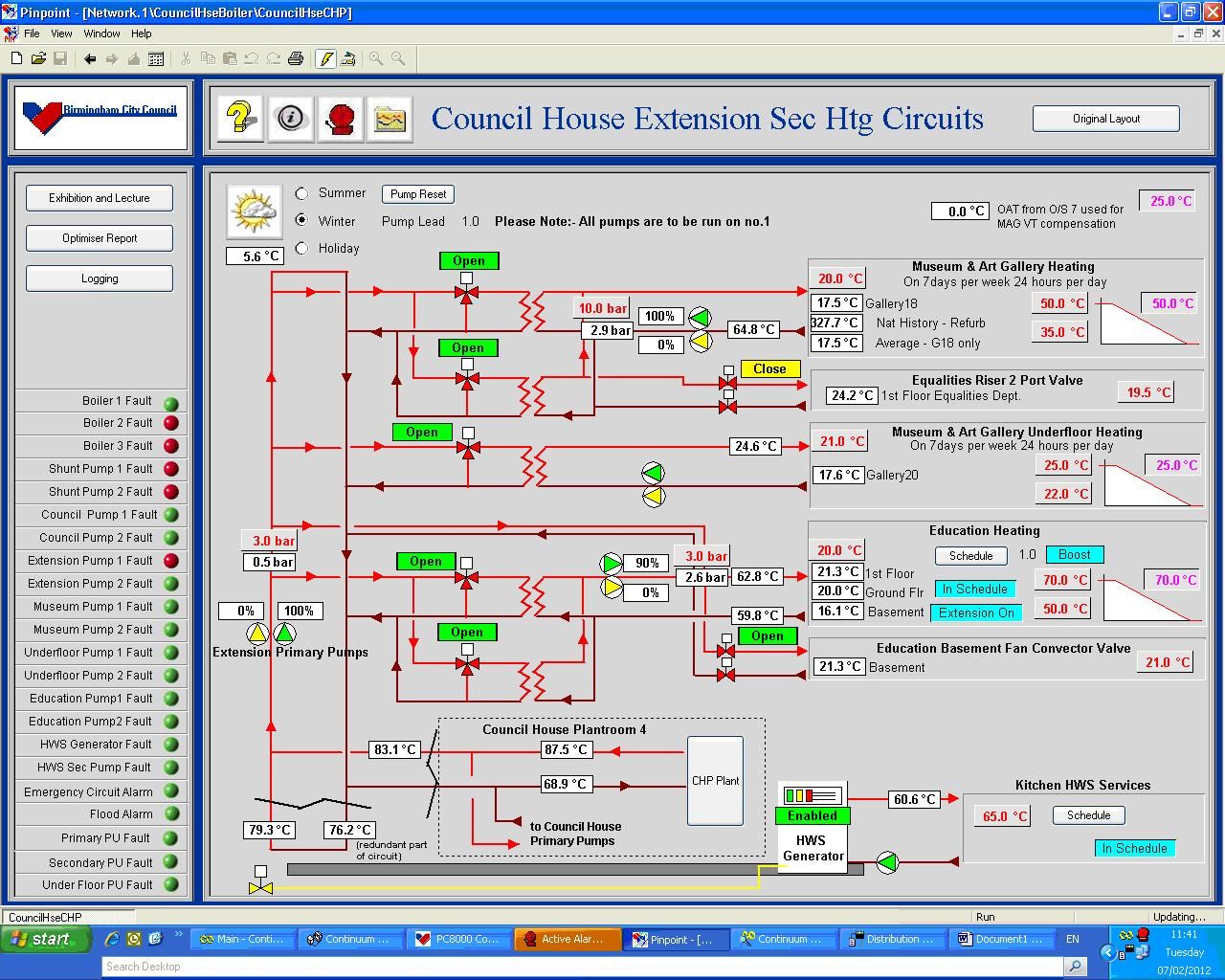Birmingham¶
Video – Savings – Service – Cost-Benefit – Exploitation – Partners
Birmingham City Council has the aim of reducing its carbon footprint by 60% by 2026 based on its 1990 baseline. The Council is also required to cope with the introduction of the ‘carbon tax’ (the UK’s carbon reduction commitment) by the Government and deliver required data. It is also working with social landlords and householders to offer energy efficiency measures in domestic buildings. Although SMARTSPACES develops technology in public buildings, its solutions can potentially be used in a domestic context – in particular awareness raising actions.
Buildings selected include the Council House (plus a smaller ‘extension’ Margaret Street building) and Birmingham Museum & Art Gallery which both represent large buildings with a high resource consumption that offered many challenges regarding the existing installations, number of rooms, building age and the various user groups within. The Council House was already using a display screen in the public area to announce meetings etc, and a dedicated screen was installed to show the SMARTSPACES energy information.
Video¶
Savings¶
For more details visit the eeMeasure tool and the SMARTSPACES deliverable D7.2 also covering qualitative surveys.
Service¶
edss¶
Over 40% of Birmingham’s carbon emissions is produced by schools – they tend to have big LED screens, pc’s in most classrooms, manually operated light switches & electrical sockets, IWB’s, etc. which all consume a lot of energy). The SMARTSPACES project has the opportunity to collaborate with The Carbon Trust, whom facilitate engagement with site staff (caretakers, site managers, bursars, etc.) and run Awareness Raising Workshops for the schools on Carbon & Energy Saving. There are currently 100 schools participating in the programme and of those 100, Phase 2 will include 26 schools participating in the Green New Deal (research indicates that also participating in the Green New Deal will push Schools energy savings from 15% to 40%).
Therefore we were keen to ensure we had the ability to replicate key messages and practical advice applications could be easily transferred to School environments.
Visitor concept and impact outside of pilot buildings: Screen-savers to push out key messages, but these messages needed to be kept simple but engaging – therefore icon/image-driven and relevant e.g. The Council House consumed 1,234 kWh this month compared to 4,567 kWh this month and self-generated 345 kWh of electricity this month and therefore contributed 0.4 % towards Birmingham’s Carbon reduction target of 60%.
ems¶
Building Managers and Energy Managers previously received data in the form of bill statements about the actual gas and electricity consumption. The Building management systems were already in place but the delivery and display of real-time data was insufficient. SMARTSPACES helped to improve the information available, making it easy to request, easy to display in customised formats and more accessible through various channels (e.g. web-based, usable on mobile devices). The Council was required to meter sites over 100 KW usage half hourly by law and from 6th April 2014 AMR’s become mandatory for larger sites for both electricity (profile 5 to 8 – non domestic customers whose meters have a register system to record maximum demand) and gas (732 megawatt hours per annum) which provided an increased number of readings. The new data streams were fed into the existing Bems (building energy management system). The pilot was used to explore how data could be integrated into the existing system. The additional readings are analysed and new intelligence is provided to the managers with a view to enabling corrective action.
Collection of real-time energy consumption data enables generation of visualised consumption patterns for the public, staff members working in the building and building professionals through the SMARTSPACES edss – Energy Decision Support Service. These are displayed in the buildings and over the internet to raise awareness. Another aim was to publish this data as public open data as part of Birmingham’s open data drive and now available through the SMARTSPACES portal for Birmingham at www.EnergySmartBirmingham.com as well as being published through the regions West Midlands Open Data Portal https://data.birmingham.gov.uk/. The project helped to link the new data display to behaviour change action with officers and the public for example through competitions, staff communication and displays at events.
Energy Managers are now in a better and more informed position to inform and support Building Managers of high consuming buildings in a more proactive way which enables them to work together to explore and identify supporting and behavioural measures to support energy reduction activities in their building.
Value propositions¶
Through SMARTSPACES city Councils are able to optimise the process of investigating any energy saving potential and improve the consumption of a wide range of buildings, all requiring little IT knowledge whilst providing reports following guidelines. The process not only brought a technological approach to energy saving but was also able to put a corporately recognised system in place.
The investigative part of the process utilised all kind of existing information such as existing AMRs and sensors as well as re-usable data loggers to increase the resolution for analysis. All data is collected in one portal and the data sets are provided under an Open Government Licence. The key staff are effective in recruiting champions on-site who disseminate the results available online and on display on screens in the pilot site buildings (which follow DECC guidelines for the display of energy performance in public buildings). This includes the raising awareness to energy decision support/behavioural changes which can be applied at the pilot sites as well as at home.
Cost-Benefit¶
The SMARTSPACES project has a positive socio-economic return paying off immediately. Some of the metering is already in place (due to regulation) and additional cost result from sub-metering. Hence, the entrance barrier for basic service provision is already taken by many other buildings in Birmingham and other cities. The decision for additional metering is likely to pay off for large consumers or buildings where wastage results in large losses (e.g. old buildings). The business model for the site is simple as it is based on hardware acquisition and fees paid for service access whilst the energy management is operated by a specialised unit within the municipality.
Exploitation¶
As a result of the successful implementation of the SMARTSPACES Service, Birmingham is now able to explore how the newly generated data can be integrated into the existing building management system, particularly in relation to load and lighting management. The SMARTSPACES initiative has also proved to be a key driver to affecting behavioural change and in turn has helped to reduce energy consumption in the three pilot sites. Such is the success of SMARTSPACES and Birmingham’s commitment to the Government’s Open Data drive, its rollout has been extended to include an additional 40 Birmingham City Council buildings, which have been added to the service and feature on www.EnergySmartBirmingham.com (Birmingham’s local SMARTSPACES portal).
Created by Birmingham’s Smart City Commission, the publication of the Roadmap to a Smarter City provides a framework to demonstrate leadership and facilitate cooperation with citywide partners in the development of our City. This work is being coordinated by Birmingham’s SmartGreen Commission. It is also essential that the City drives down their carbon dioxide (CO2) emissions so that it contributes to the national and global effort to tackle climate change. The development of a Birmingham Carbon Roadmap will also assist with this challenge, which will be co-ordinated by Birmingham’s Green Commission..
The ICT-enabled solutions including the data portal, public data availability and the energy analysis is being run by Stark International and Schneider Electric. The City will continue to exploit the success of the SMARTSPACES service and look at to implementation across Birmingham’s building portfolio with a view to engaging citizens and communities through Birmingham’s Energy Savers programme.
Partners¶
Birmingham City Council (BCC) is Europe’s largest unitary local authority. Its approximately 50,000 staff provides services to over one million residents representing the most ethnically diverse city in the UK. BCC is one of the local authorities at the cutting edge in terms of integrating digital technologies into all aspects of its services in order to transform them and has undergone a radical business transformation programme that is on target to achieve net efficiency savings in excess of £1 billion over a ten year period.





